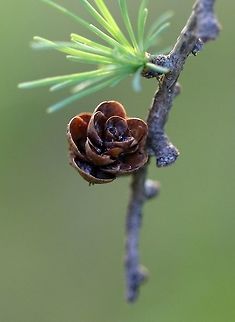
Appearance
"Larix laricina" is a small to medium-size boreal coniferous and deciduous tree reaching 10–20 m tall, with a trunk up to 60 cm diameter.Tamaracks and Larches are deciduous conifers. The bark is tight and flaky, pink, but under flaking bark it can appear reddish. The leaves are needle-like, 2–3 cm short, light blue-green, turning bright yellow before they fall in the autumn, leaving the pale pinkish-brown shoots bare until the next spring.
The needles are produced spirally on long shoots and in dense clusters on long woody spur shoots. The cones are the smallest of any larch, only 1–2.3 cm long, with 12-25 seed scales; they are bright red, turning brown and opening to release the seeds when mature, 4 to 6 months after pollination.
Key characteristics:
⤷ The needles are normally borne on a short shoot in groups of 10–20 needles.
⤷ The larch is deciduous and the needles turn yellow in autumn.
⤷ The seed cones are small, less than 2 cm long, with lustrous brown scales.
⤷ Larch are commonly found in swamps, fens, bogs, and other low-land areas.
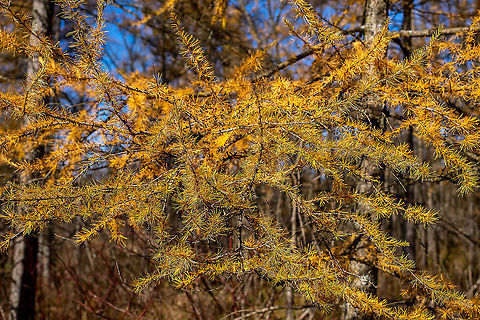
Naming
The word "tamarack" is an Algonquian name for the species and means "wood used for snowshoes".The central Alaskan population, separated from the eastern Yukon populations by a gap of about 700 kilometres, is treated as a distinct variety "Larix laricina" var. "alaskensis" by some botanists, though others argue that it is not sufficiently distinct to be distinguished.
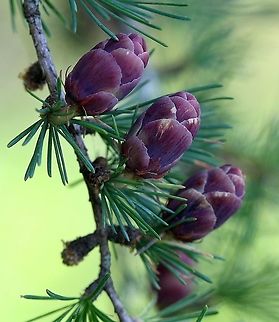
Distribution
Tamaracks are very cold tolerant, able to survive temperatures down to at least −65 °C, and commonly occurs at the Arctic tree line at the edge of the tundra. Trees in these severe climatic conditions are smaller than farther south, often only 5 m tall.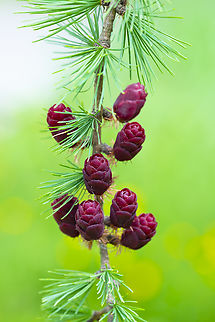
Habitat
They can tolerate a wide range of soil conditions but grow most commonly in swamps, bogs, or muskeg in wet to moist organic soils such as sphagnum peat and woody peat. They are also found on mineral soils that range from heavy clay to coarse sand; thus texture does not seem to be limiting. Although tamarack can grow well on calcareous soils, it is not abundant on the limestone areas of eastern Ontario.Tamarack is commonly an early invader. Tamarack is generally the first forest tree to invade filled-lake bogs. In the lake states, tamarack may appear first in the sedge mat, sphagnum moss, or not until the bog shrub stage. Farther north, it is the pioneer tree in the bog shrub stage. Tamarack is fairly well adapted to reproduce successfully on burns, so it is one of the common pioneers on sites in the boreal forest immediately after a fire.
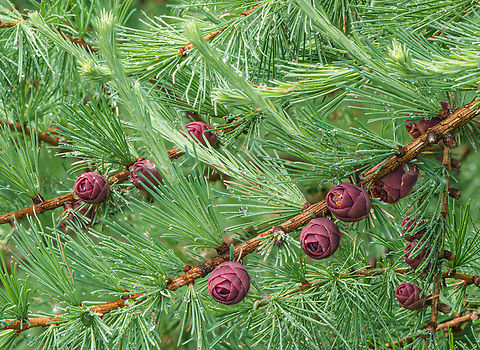
Uses
The wood is tough and durable, but also flexible in thin strips, and was used by the Algonquian people for making snowshoes and other products where toughness was required. The natural crooks located in the stumps and roots are also preferred for creating knees in wooden boats. Currently, the wood is used principally for pulpwood, but also for posts, poles, rough lumber, and fuelwood; it is not a major commercial timber species.It is also grown as an ornamental tree in gardens in cold regions. Several dwarf cultivars have been created that are available commercially. Tamarack is commonly used for bonsai.
The aboriginal peoples of Canada's northwest regions used the inner bark as a poultice to treat cuts, infected wounds, frostbite, boils and hemorrhoids. The outer bark and roots are also said to have been used with another plant as a treatment for arthritis, cold and general aches and pains.
Wildlife use the tree for food and nesting. Porcupines eat the inner bark, snowshoe hares feeds on tamarack seedlings, and red squirrels eat the seeds. Birds that frequent tamaracks during the summer include the white-throated sparrow, song sparrow, veery, common yellow throat, and Nashville warbler.
References:
Some text fragments are auto parsed from Wikipedia.